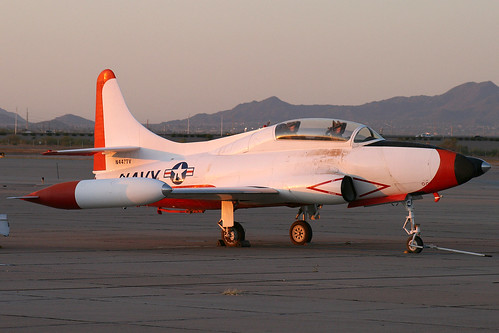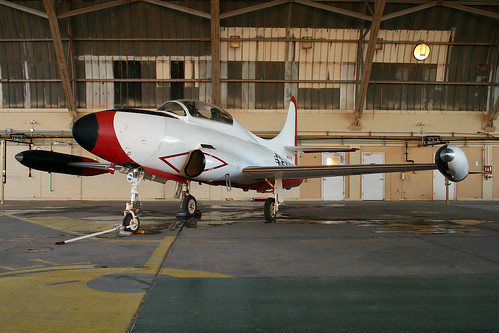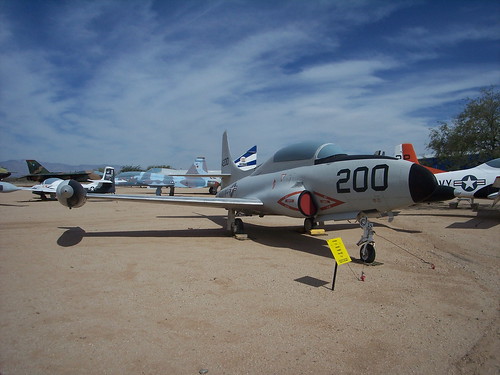Lockheed T2V SeaStar Picture
More Lockheed T2V SeaStar Videos 1

|
|
 |
 Picture:
A T2V-1 (T-1A) SeaStar (foreground) and a TV-2 (T-33B) Shooting Star in flight in the early 1950s Picture:
A T2V-1 (T-1A) SeaStar (foreground) and a TV-2 (T-33B) Shooting Star in flight in the early 1950s |
Role - Naval training aircraft
Manufacturer - Lockheed
First flight - 15 December 1953
Introduced - May 1957
Retired - 1970s
Primary user - United States Navy
Number built - 150
Developed from - T-33 Shooting Star
The Lockheed T2V SeaStar, later called the T-1 SeaStar, was a turbojet trainer aircraft for the U.S. Navy that entered service in May 1957. It was developed from the Lockheed T-33 and powered by one Allison J33 engine.
Design and development
Starting in 1949, the US Navy used the Lockheed T-33 for land-based jet aircraft training. The T-33 was a derivative of the P-80 fighter and was first named TO-2, then TV-2 in Navy service. However, the TV-2 was not suitable for operation from aircraft carriers. The persisting need for a carrier-compatible trainer led to a further, more advanced design development of the P-80/T-33 family, which came into being with the Lockheed designation L-245 and US Navy designation T2V.
Compared to the TV-2, the T2V was almost totally re-engineered for carrier landings and at-sea operations with a redesigned tail, naval standard avionics, a strengthened undercarriage (with catapult fittings) and lower fuselage (with a retractable arrestor hook), and power-operated leading-edge flaps (to increase lift at low speeds) to allow carrier launches and recoveries, and an elevated rear (instructor's) seat for improved instructor vision, among other changes. Unlike other P-80 derivatives, the T2V could withstand the shock of landing on a pitching carrier deck and had a much higher ability to withstand sea water-related aircraft wear from higher humidity and salt exposure.

Operational history
The only version of the T2V was initially designated T2V-1 when it entered service, but was redesignated T-1A SeaStar under the 1962 United States Tri-Service aircraft designation system, a name under which it would spend the majority of its career.
The T-1A was replaced by the T-2 Buckeye but remained in service into the 1970s.
Operators
United States
- United States Navy
Specifications (T2V-1)
General characteristics
- Crew: Two (student & instructor)
- Length: 38 ft 6.5 in (11.75 m)
- Wingspan: 42 ft 10 in (13.05 m)
- Height: 13 ft 4 in (4.06 m)
- Wing area: 240 ft² (22.3 m²)
- Empty weight: 11,965 lb (5,438 kg)
- Loaded weight: 15,500 lb (7,045.45 kg)
- Max takeoff weight: 16,800 lb (7,636 kg)
- Powerplant: 1× Allison J33-A-24/24A turbojet, 6,100 lbf (2,772 kN)
Performance
- Maximum speed: 521 knots (600 mph, 973 km/h)
- Range: 782 nm (900 mi, 1,448 km)
- Service ceiling: 40,000 ft (12, 200 m)
- Rate of climb: 6,300 ft/min (32 m/s)
Related development
- T-33 Shooting Star
- P-80 Shooting Star
Comparable aircraft
- F9F-8T/TF-9J Cougar
- TA-4F/J Skyhawk
- Fouga Zephyr
- T-2 Buckeye
- T-45 Goshawk
References
- Ginter, Steve. Lockheed T2V-1/T-1A Seastar. Naval Fighters #42. Simi Valley, California: Ginter Books, 1999. ISBN 978-0-942612-424.
- Green, William, with Gerald Pollinger. The Aircraft of the World. New York; Doubleday & Co., 1965. P. 255.
- Green, William, with Dennis Punett. MacDonald World Air Power Guide. London; Purnell & Sons, Ltd. (reprinted by Doubleday), 1963. P. 28.
Living Warbirds: The best warbirds DVD series.
Source: WikiPedia